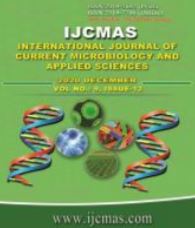


 National Academy of Agricultural Sciences (NAAS)
National Academy of Agricultural Sciences (NAAS)

|
PRINT ISSN : 2319-7692
Online ISSN : 2319-7706 Issues : 12 per year Publisher : Excellent Publishers Email : editorijcmas@gmail.com / submit@ijcmas.com Editor-in-chief: Dr.M.Prakash Index Copernicus ICV 2018: 95.39 NAAS RATING 2020: 5.38 |
An investigation entitled Evaluation of new herbicides and its combination for effective weed management in Chickpea (Cicer arietinum L.) was carried out during Rabi season of year 2017-18 and 2018-19 at Agronomy Research Farm, Acharya Narendra Deva University of Agriculture and Technology. Kumarganj, Ayodhya (U.P.). Experiment was carried out with 12 treatments viz: T1- Imazethapyr + imazamox (PRE), T2- Imazethapyr+ imazamox (POE) at 3-4 leaf stage, T3- Imazethapyr (POE) at 3-4 leaf stage, T4-Quizalofop ethyl (POE) at 3-4 leaf stage, T5-Clodinofop (POE) at 3-4 leaf stage, T6-Pendimethalin (PE), T7-Pendimethalin (PE)+ Imazethapyr (POE), T8-Oxyfluorfen (PE), T9- Oxyfluorfen (PE)+ Quizalofop (POE), T10- 1 Hand Weeding at 35-40 DAS, T11- Weed Free and T12- Weedy Check respectively laid out in Randomized Block Design with three replication. The objective of the study was to find out the effect of herbicides on growth and yield of chickpea. Different weed control treatments did not influence the number of plants m-2, plant height and dry weight of plants at 30th day stage of crop growth. At 60th, 90th and at harvest stages, post-emergence application of either Quizalofop or imazethapyr at 60 g ha-1, each applied in the pendimethalin 1000 g ha-1 or oxyfluorfen 200 g ha-1 as pre-emergence treated plots (T7 & T9) being at par recorded significantly higher plant height and crop dry matter over rest of the treatments including only the application of either pendimethalin 1000 g ha-1 or oxyfluorfen 200 g ha-1 as pre-emergence alone (T6 and T7).
 |
 |
 |
 |
 |